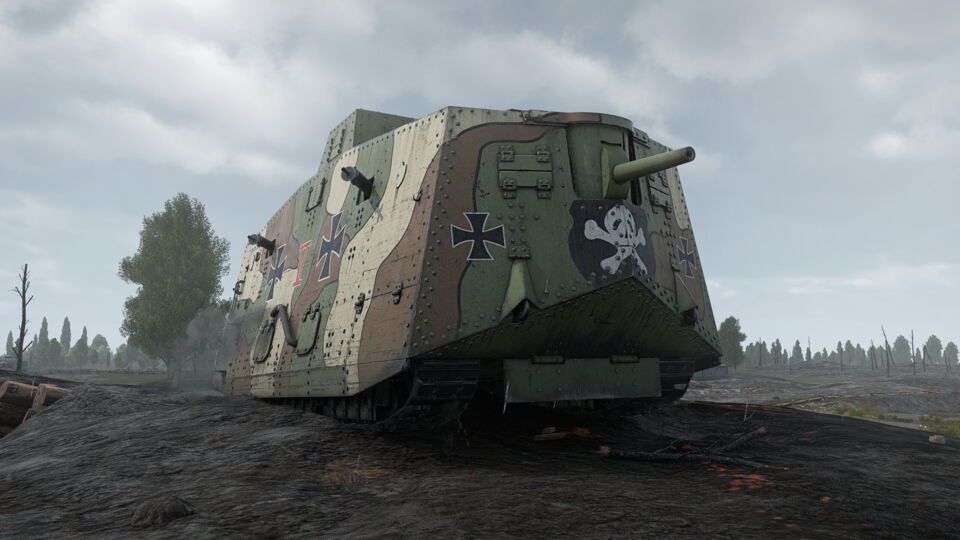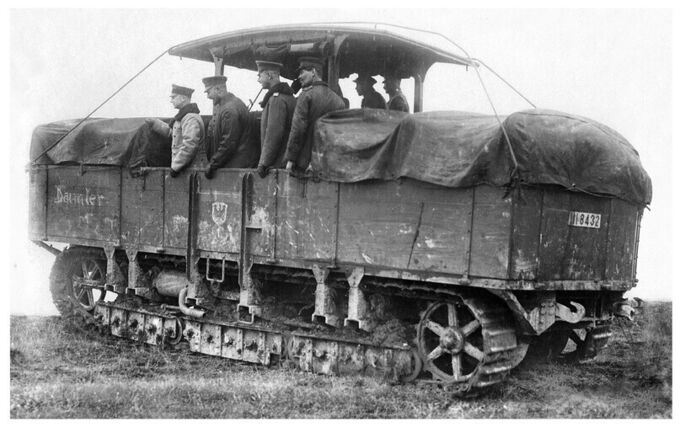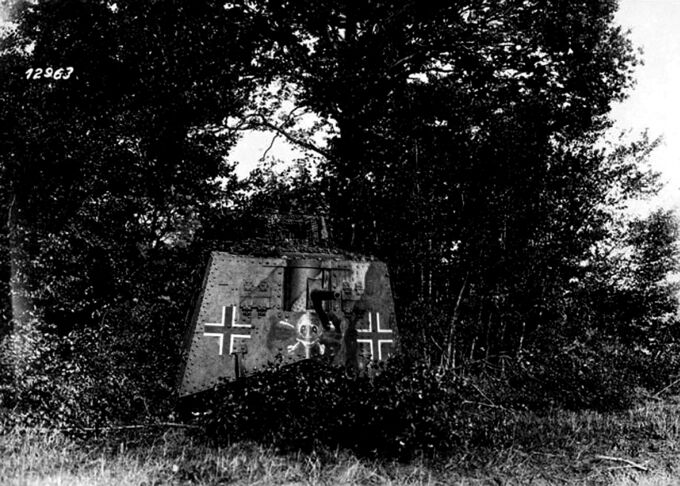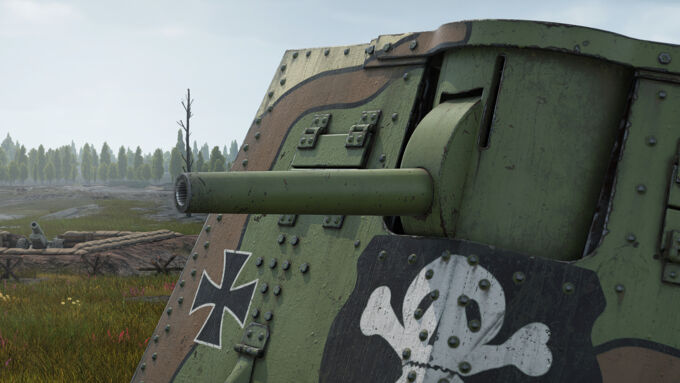The German Sturmpanzerwagen A7V Heavy Tank was Germany’s response to the first British tanks in WW1. Designing started in 1916 with the founding of the Allgemeines Kriegsdepartement Sektion 7 Verkehrswesen, which was made to start research on tanks, with the first prototype completed in late April of 1917. Shortly after, in May, the first wooden mockup was built with a rear facing cannon, which was later removed and replaced by machine guns.
| Pros | Cons |
|---|---|
| High explosive filler in APHE round | Slow |
| A lot of crew | Casemate turret |
| Loads of Gun depression/elevation | Bad Ammo placement => Bad survivability |
| Good frontal armor |
History
The German tank development project began after the first British tanks appeared on the Western Front in September 1916. The German War Ministry formed a committee to investigate tank design, led by Joseph Vollmer, who had experience in the automobile industy. The tank was designed to cross ditches, be armed with a cannon and machine guns, and reach a speed of 13 km/h. Its design was based on the American Holt tractor.
A prototype was completed in April 1917 by Daimler, and by May, a wooden mockup was demonstrated in Mainz. The rear-facing cannon was removed in the final design, and the number of machine guns increased to six. The first pre-production model was finished in September 1917, with Assault Tank Units 1 and 2 formed in the same month. Only 10 were ever finished to see combat, with the rest being used as Cargo vehicles as they weren’t equiped with any armor. Sadly, today only 1 A7V called “Mephisto” exists, which now stands in the Australian War Memorial in Canberra.
The A7V did see some action, with five of them being used on the 21th of March for the first time. In true German fashion, three of them suffered mechanical issues before even reaching the battlefield, the other two only fought in a minor battle.
The A7V also took part in the first ever tank to tank engagement in history. Sadly, this event isn’t well documented, and sources have different stories.
According to Source 1 and 2:
On the 24th of April, 3 A7Vs (Mephisto, Nixe and Elfride) incidentally met 3 British Mark IVs. Two of the Female Mark IVs retreated as they were damaged from the armor-piercing bullets from the A7V, and because weren’t armed with any weapons that could damage the A7Vs. The single Male Mark IV hit the commanding A7V three times, making the crew bail, where 5 of them were killed. The remaining two German tanks then retreated after seeing the Mark IV taking out friendly infantry. Sadly, the Mark IV was abandoned after being hit by a mortar shell, and the two A7Vs broke down on their retreat and were blown up to prevent the capture and reuse by the Allies.
According to Source 3:
The A7V “Nixe” advanced towards Cachy but was delayed by mechanical issues. As the fog cleared, it encountered three British Mark IV tanks. The German crew, initially unaware they were under fire because of the loud interior of the tank, believed they had disabled one of the tanks as it was not moving. In reality, the Mark IV had paused to give its gunner a better shot. The A7V then targeted and disabled two of the female British tanks as they tried to retreat before being hit by the third one whose gunner had aimed properly, which killed the gunner and wounded 5 other crew. Fearing an explosion, the remaining crew temporarily abandoned the vehicle. After the British tanks withdrew, the crew remounted the German tank and managed to drive it back 2 kilometers before it broke down due to an oil leak caused by the two hits it took from the 6 pounder guns. This battle near Villers-Bretonneux became the first recorded tank-vs-tank engagement in history. The encounter ended in a stalemate.
Survivability
All things considered, the A7V’s armor isn’t made out of paper, with 30mm of steel at the front and 20mm in the sides, meaning some opponents you will face won’t penetrate you from the front if you are angling correctly. Angling is definitely recommended, as it will help you greatly, and the neutral steering of the tank makes it a lot more easy. When angling, try to line the edge up with the enemy, meaning you should angle at about 40°.
You might think that having 18 crewmembers the survivability of the A7V must be good, but you’re mistaken… most of the times at least. If you’re playing against competent enemies or enemy tanks with high explosive filler, you will find yourself often dying in one hit, or being crippled a lot. Why? The majority of the crew is placed in the front of the tank, where all of the ammo is stored, meaning if the ammo detonates due to being hit, at least the entire front of your tank will be wiped out, if not the entire tank. In normal GRB matches you will find yourself often tanking shots though, due to most of the tanks you face having low to no explosive filler (Except for tanks like the Mark IV).
There are 2 crewmembers in the little box on the tank, including the driver. The rest of the crew is in the rear of the tank, where the 2 machine guns are.
Arnament
The A7V’s main arnament was a 5.7cm Maxim-Nordenfelt gun, which was built by Great Britain in the late 1880s. Later, it was sold to the Belgians where it was stolen by the Germans and built into the A7V.
The 5.7cm gun in the is one of the best guns when compared with others its age, making quick work of anything it penetrates with its high explosive filler and penetration. You do have to keep in mind that it is still a casemate. You have 20 degrees of vertical guidance in both directions, and 45 degrees in both horizontal directions which is a lot compared to other casemates.
The gun can be loaded in both APHE and HE, with the APHE usually being the better pick
| Ammunition | Type | Pentration | Explosive filler | Use |
|---|---|---|---|---|
| Gr.m.P. | APHE | 38mm at 100m, 32mm at 500m | 120g of Fp.02 | Main penetrating round which can also be used to overpressure light vehicles |
| Gr. | HE | 6mm at 100m, 5mm at 500m, | 160g of Fp.02 | Backup round if those 40g of extra TNT matter, or if you overpen |
The only time where HE is the better pick, is when facing an open tank like AA, where the normal APHE round overpenetrates and doesn’t detonate.
Armed with 6 7.92 mm MG08 machine guns on all sides except the front, the A7V is protected against infantry from all angles. In-game, this means if you are caught off guard from an open-topped vehicle, you will still have a chance at defending yourself. Don’t expect to penetrate any armor with these though, and don’t expect to shoot down planes with these due to their small caliber and bad vertical guidance.
Mobility
Germany’s other WW1 tanks are not necessarily the fastest, with the Beutepanzer IV being able to drive 6 km/h forwards. While the A7V drives more than double the speed of the Beutepanzer, 13 km/h is still not the best, meaning in battle you will most likely arrive last, and won’t be able to flee difficult situations like other tanks might be able to, escpecially with its poor reverse speed of 6 km/h.
The tank is outfitted with a 200 hp engine, meaning with 30 tons of mass you get a power to weight ratio of 6.7 per ton. This probably won’t matter though as your low top speed hides your bad acceleration.
Usage in battle
When using the tank in battle, it’s best to adopt a sniping approach. The tank has poor survivability against enemies who can accurately shoot its weak spots. Its high gun depression proves useful, allowing you to utilize hills for cover while still returning fire. Additionally, angling the tank is highly recommended as it will greatly enhance its armor, making it hard to penetrate from the front. The high horizontal guidance proves useful here. Effective positioning and careful maneuvering will maximize its survivability and combat effectiveness. Be wary that your low hp/t ratio will make it hard to climb a lot of hills
Brawling works really well if you’re facing nations like Great Britain or Sweden, which mostly have rounds with no explosive filler, meaning you will tank a lot more. Do be wary that your round does not penetrate much, meaning you will have to be able to quickly aim for weakspots.
When playing maps which consist of mostly close-quarters, try to find a spot with high traffic, and wait patiently in order to catch enemy tanks off-guard and hit them in the side. You cannot flank with it as its incredibly slow and sniping in maps like Advance to Rhine will force you to expose yourself.
Be prepared to arrive last and miss a lot of the action. You will not be able to quickly rotate between points and move out of danger.
| Opponent | Reaction |
| Fast tanks (BT-5, BT-7 or M3 Stuart) | Try to not get caught off-guard and listen to engine sounds carefully |
| Other landships (LVT (A) (1), T-28) | Memorize spots where you can penetrate it, and the high explose filler of the APHE should do the rest |
| Medium tanks | Nothing special except trying to find weakspots |
| Tank destroyers | With open tops you can use the HE round, but only if you would overpen otherwise |
| Completely open vehicles | Same with normal open tops, except HE is more useful and the MGs will help you |











